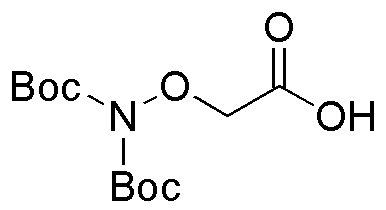Bis-Boc-amino-oxyacetic acid is widely utilized in research focused on:
- Peptide Synthesis: This compound serves as a protecting group in the synthesis of peptides, allowing for selective reactions without interfering with other functional groups. This is particularly beneficial in the pharmaceutical industry for developing new drugs.
- Bioconjugation: It is used in bioconjugation processes, where it helps in attaching biomolecules to surfaces or other molecules. This application is crucial in the development of targeted drug delivery systems.
- Analytical Chemistry: The compound is employed in analytical methods to improve the stability and solubility of certain analytes, enhancing the accuracy of various assays and tests in laboratories.
- Research in Medicinal Chemistry: It plays a significant role in the modification of small molecules to enhance their bioavailability and therapeutic efficacy, making it valuable for researchers in drug development.
- Material Science: The compound is also explored in the development of advanced materials, such as hydrogels, which have applications in tissue engineering and regenerative medicine.
General Information
Properties
Safety and Regulations
Applications
Bis-Boc-amino-oxyacetic acid is widely utilized in research focused on:
- Peptide Synthesis: This compound serves as a protecting group in the synthesis of peptides, allowing for selective reactions without interfering with other functional groups. This is particularly beneficial in the pharmaceutical industry for developing new drugs.
- Bioconjugation: It is used in bioconjugation processes, where it helps in attaching biomolecules to surfaces or other molecules. This application is crucial in the development of targeted drug delivery systems.
- Analytical Chemistry: The compound is employed in analytical methods to improve the stability and solubility of certain analytes, enhancing the accuracy of various assays and tests in laboratories.
- Research in Medicinal Chemistry: It plays a significant role in the modification of small molecules to enhance their bioavailability and therapeutic efficacy, making it valuable for researchers in drug development.
- Material Science: The compound is also explored in the development of advanced materials, such as hydrogels, which have applications in tissue engineering and regenerative medicine.
Documents
Safety Data Sheets (SDS)
The SDS provides comprehensive safety information on handling, storage, and disposal of the product.
Product Specification (PS)
The PS provides a comprehensive breakdown of the product’s properties, including chemical composition, physical state, purity, and storage requirements. It also details acceptable quality ranges and the product's intended applications.
Certificates of Analysis (COA)
Search for Certificates of Analysis (COA) by entering the products Lot Number. Lot and Batch Numbers can be found on a product’s label following the words ‘Lot’ or ‘Batch’.
Numéro de catalogue
Numéro de lot/série
Certificates Of Origin (COO)
This COO confirms the country where the product was manufactured, and also details the materials and components used in it and whether it is derived from natural, synthetic, or other specific sources. This certificate may be required for customs, trade, and regulatory compliance.
Numéro de catalogue
Numéro de lot/série
Safety Data Sheets (SDS)
The SDS provides comprehensive safety information on handling, storage, and disposal of the product.
DownloadProduct Specification (PS)
The PS provides a comprehensive breakdown of the product’s properties, including chemical composition, physical state, purity, and storage requirements. It also details acceptable quality ranges and the product's intended applications.
DownloadCertificates of Analysis (COA)
Search for Certificates of Analysis (COA) by entering the products Lot Number. Lot and Batch Numbers can be found on a product’s label following the words ‘Lot’ or ‘Batch’.
Numéro de catalogue
Numéro de lot/série
Certificates Of Origin (COO)
This COO confirms the country where the product was manufactured, and also details the materials and components used in it and whether it is derived from natural, synthetic, or other specific sources. This certificate may be required for customs, trade, and regulatory compliance.


